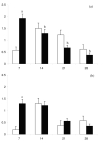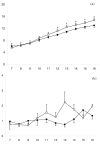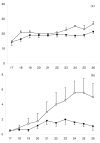The relationship between uterine pathogen growth density and ovarian function in the postpartum dairy cow
- PMID: 17574659
- PMCID: PMC2702080
- DOI: 10.1016/j.theriogenology.2007.04.056
The relationship between uterine pathogen growth density and ovarian function in the postpartum dairy cow
Abstract
In cattle, the first postpartum dominant follicle grows slower and produces less oestradiol in animals with high numbers of bacteria contaminating the uterine lumen. However, only bacteria that are uterine pathogens are correlated with severe clinical disease and an increased inflammatory response. It is unknown whether the effect on the ovary in relation to uterine bacterial contamination is associated with the presence of recognised uterine pathogens. Therefore, the present study examined the relationship between pathogenic bacteria in the postpartum uterine lumen, follicle growth and function and the formation of a competent corpus luteum. In addition, peripheral plasma concentrations of immune mediators were quantified. Swabs were collected from the uterine lumen of cattle on day 7 postpartum. Bacteria were cultured and identified and bacterial growth was scored semi-quantitatively. Animals were categorized into high or low recognized uterine pathogen contamination groups based on the number of colonies. Ovarian structures were monitored by daily transrectal ultrasonography and blood samples were collected. In animals with high numbers of uterine pathogens on day 7 postpartum, the diameter of the first postpartum dominant follicle was smaller and plasma oestradiol concentrations were lower. In addition, these animals had smaller corpora lutea, which produced less progesterone. Furthermore, animals with a high day 7 uterine pathogen growth density had higher peripheral concentrations of acute phase proteins. Thus, contamination of the uterus with recognized uterine pathogens is associated with ovarian dysfunction during the postpartum period. Furthermore, infection results in an increase in the production of inflammatory mediators.
Figures







References
-
- AFRC . Energy and protein requirements of ruminants. CAB International; 1993.
-
- Barrow GI, Feltham RKA. Cowan and Steel’s Manual for the Identification of Medical Bacteria. Cambridge University Press; Cambridge: 1993.
-
- Battaglia D, Beaver AB, Harris TG, Tanhehco E, Viguie C, Karsch FJ. Endotoxin Disrupts the Estradiol-Induced Luteinizing Hormone Surge: Interface with Estradiol Signal Reading, Not Surge Release. Endocrinology. 1999;140:2471–2479. - PubMed
-
- Baumann H, Gauldie J. The acute phase response. Immunol Today. 1994;15:74–80. - PubMed
-
- Bondurant RH. Inflammation in the Bovine Reproductive Tract. J Anim Sci. 1999;77 - PubMed
Publication types
MeSH terms
Substances
Grants and funding
LinkOut - more resources
Full Text Sources
Medical

